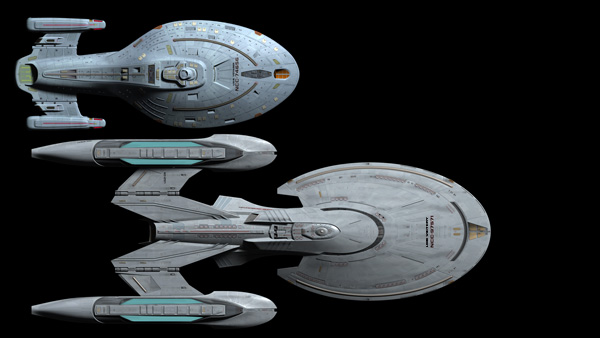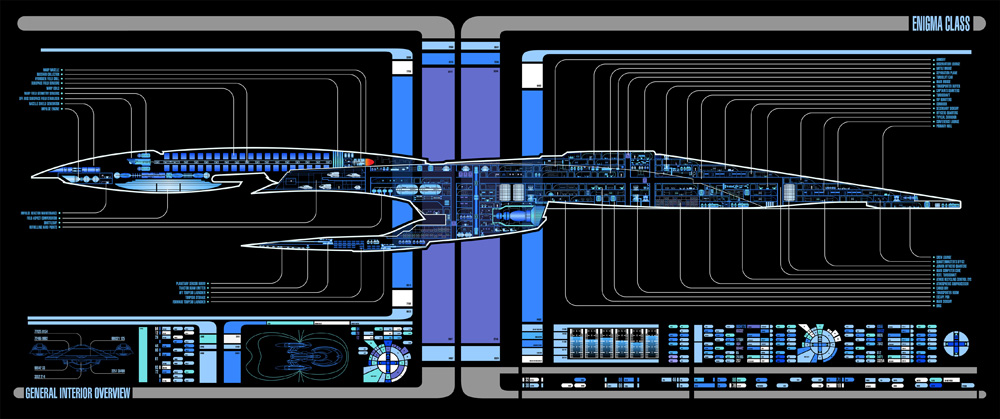Specifications - USS Victory NCC-97571
Summary
Specification information for the Enigma-Class starship, USS Victory NCC-97571
General
| Class | Enigma Class | |
| Role | Exploration/Battlecruiser | |
| Duration | 80 years | |
| Time Between Refits | 20 years | |
| Time Between Resupply | 5 years |
Dimensions
| Length | 442 meters | |
| Width | 404 meters | |
| Height | 179 meters | |
| Decks | 14 | |
| Mass (Metric Tons) | 1,400,000 |
Personnel
| Officers | 50 | |
| Enlisted Crew | 110 | |
| Marines | 75 | |
| Emergency Capacity | 350 |
Speed
| Cruise Speed | Warp 9.1 | |
| Maximum Speed | Warp 9.8 | |
| Emergency Speed | Warp 9.925 (for 34 hours) | |
| Slipstream | Quantum Slipstream Velocity equivalent to 9.999997359835618 ( for 12 hours before a 'cool down' of 7 hours ) | |
| Nacelles | 2 (Variable geometry - pivot for warp flight) |
Weapons & Defensive Systems
| Shields & Sensors | Shields: Class 10 Hull Conformal, Regenerative/Auto-Modulating/Metaphasic shielding system Hull Armor: Type-1 Ablative Armor The Multi-Layered Shielding System (M.L.S.S.) Layer 3 - The outermost layer manipulates graviton polarity in a way not typical to shields, creating a graviton flux disruption that prevents many know designs of threat tractor beams from locking on to the vessel. This layer also incorporates transport inhibitor technology, helping prevent an enemy from transporting aboard. Layer 2 - The middle layer incorporates automatic rotation of frequency and modulation with meta-phasics, which absorbs enemy fire, spreads it out along the shield. This shield sends data on what type of weapon is used and what frequency and phase the weapon uses. Once this is analyzed, the computer can automatically configure shield to have the same frequency as the incoming weapon, but to different modulation, which dramatically increases shield efficiency. Layer 1 - The innermost shield layer is a multi-phaseic shield. Based on standard regenerative shielding, this is the ship's last shielded line of defense, once this is gone the ships only defense is the Ablative Hull Armor. The key to this layer is its ability to 'wave' while in a state of temporal flux. This technology was developed in part by the crew of USS Voyager and the Mannheim Research Station. Instead of a standard oval bubble, this layer 'ripples' or waves (like the surface of water) while in a state of temporal flux. This dramatically increases protection against weapons such as the Hellfire, Chronaton, and Transphasic Torpedoes while at the same time helping protect the ship from temporal anomalies. The design of the M.L.S.S. was modified just prior to its entering service, in 2376, in order to increase effectiveness against both high-energy tractor beams and phased polaron particles, measures clearly aimed at the Borg and Dominion respectively. Under normal operation the shield modulation frequencies are under the control of the ships computer system, which continually evaluates incoming weapons fire and automatically re-modulates the shields to give the most effective possible defense. It is thought that this system, in conjunction with transport inhibitor technology, will also enable the shield system to prevent beam-through by Borg and Dominion transporter technology. |
|
| Weapon Systems | Phasers: 11 Type-X phaser arrays Torpedoes: launchers: 3 (2 forward, 1 aft) Photon: 230 Quantum: 100 Tri-cobalt: 10 |
|
| Armament | Hull Armor: Type-1 Ablative Armor. Upgraded with an organic resin developed by the same research which created the bio-neural gel-pack technology used in starship computer systems. The organic resin bonds with the hull, and is capable of repairing some damage as well as strengthening the armored hull plates providing an additional level of protection against damage and attack. Warp Engine specifications Primary Warp Core Reactor: M/ARA Class IX Secondary Warp Core Reactor: M/ARA Class VII Propulsion System: 2 24 coil low distortion Warp Nacelles Fuel (Matter Injector): Deuterium Regulator: Dilithium crystal Fuel (Antiproton Injector): antimatter Fuel Replenishment: Bussard ramjet Collectors |
|
| Navigational Deflectors | Type: Molybdenum & Duranium Mesh Power: Six Graviton Polarity Generators Output: 400 Gigawatts Field Strength: 650 Millicochranes |
|
| Tractor Emitters | Power: 3-15 Gigawatt Multi-phase Graviton Polarity Sources Field Strength: 480 Millicochranes Minimum Range: 126 Million tons at 2 Kilometers Maximum Range: 1 ton at 30.000 Kilometers |
|
| Personnel Transporters | Rooms: 5 Transporter Rooms, six persons per cycle Payload: 960 kilograms Range: 40,000 kilometers Operations Per Hours: 100 persons per hour, per room |
|
| Cargo Transporters | Rooms: 4 Transporters, 1 per primary cargo bay Payload: 800 tons Range: 40,000 kilometers Operations Per Hours: 100 cycles per hour, per room |
|
| Computer Systems | Software Version: LCARS 6.2 Storage Capacity: 1145 TeraQuads Processing Speed: 645,000 ExaFLOPS Computer specifications Number of computer cores: Two. The primary computer core is accessed in the control room on Deck 5 in amidships for maximum protection. It covers five decks and extends from Deck 2 to Deck 5. The Auxiliary core is located on Deck 10 and extends down to Deck 12, covering three decks. It is fed by two sets of redundant EPS conduits as well as primary power. Type: The AC-15 series computer core is built under contract for the Prometheus class vessel by Krayne Systems, an independent contractor based on Bynar. The structure of the computer is similar to that of most other supercomputing systems in use by Federation vessels with stack segments extending through the ship forming trillions of trillions of connections through the processing and storage abilities of modern isolinear chips. Cooling of the isolinear loop is accomplished by a regenerative liquid helium loop, which has been refit to allow a delayed-venting heat storage unit for "Silent Running.” For missions, requirements on the computer core rarely exceed 45-50% of total core processing and storage capacity. The rest of the core is utilized for various scientific, tactical, or intelligence gathering missions - or to backup data in the event of a damaged core. Bio-Neural Gel Packs: Referred to typically as BNGs, Bio-Neural Gel Packs are a new innovation in shipboard data processing and routing. Mounted at strategic locations along the ODN pathways, each BNG consists of an artificial bio-fluid that allows transmission of neural signals. The heart of the BNG is a packet of neural clusters, grown copies of strands similar to those found in the brains of sentient beings. These clusters give the ship’s computer ‘instinctive’ data processing and routing ability as well as allowing the ship’s computer to utilize ‘fuzzy logic’ to speed up probability calculations much as a living, breathing entity would. LCARS Acronym for Library Computer Access and Retrieval System, the common user interface of 24th century computer systems, based on verbal and graphically enhanced keyboard/display input and output. The graphical interface adapts to the task, which is supposed to be performed, allowing for maximum ease-of-use. The Prometheus class operates on LCARS build version 4.5 to account for increases in processor speed and power, limitations discovered in the field in earlier versions, and increased security. UNIVERSAL TRANSLATOR All Starfleet vessels make use of a computer program called a Universal Translator that is employed for communication among persons who speak different languages. It performs a pattern analysis of an unknown language based on a variety of criteria to create a translation matrix. The translator is built in the Starfleet badge and small receivers are implanted in the ear canal. The Universal Translator matrix aboard Enigma-Class starships consists of well over 100,000 languages and increases with every new encounter |
|
| Communications Systems | Short Range: 3,200,000 Kilometers Long Range: 20 Light-years for Real-Time Transmission Transmission Capacity: 18.5 kiloquads per second Transmission Speed: Warp 9.9997 |
Auxiliary Craft
| Shuttlebays | 2 | |
| Shuttles | 4 Type-9 Medium Short-Range Shuttlecraft 2 Type-6 Medium Short-Range Shuttlecraft 1 Type-8 Cargo Shuttle 2 Type-18 Shuttlepods 2 Work Bee Maintenance Pods |
|
| Attack Fighters | 8 Valkryie-Class Enhanced Operation Vessel | |
| Runabouts | 2 Danube Class Runabout |
Design History
| Design History | Taking advantage of variable geometry nacelles, pioneered on the Charleston class, the Enigma is one of fastest ships in the Fleet. The Enigma is also well protected with Auto-Modulating Metaphasic Shielding. Weapons systems on the other hand are slightly scaled back, mostly due to power allocation needs, but for a ship of it's size the Enigma class packs a punch. Even with her small size, the Enigma is an effective explorer with a modern sensor suite and science facilities. With the battle fleet, the Enigma class service as an effective scout vessel, able to watch after herself with firepower enough to eliminate any threat its size or smaller and the speed to escape from larger vessels. |



